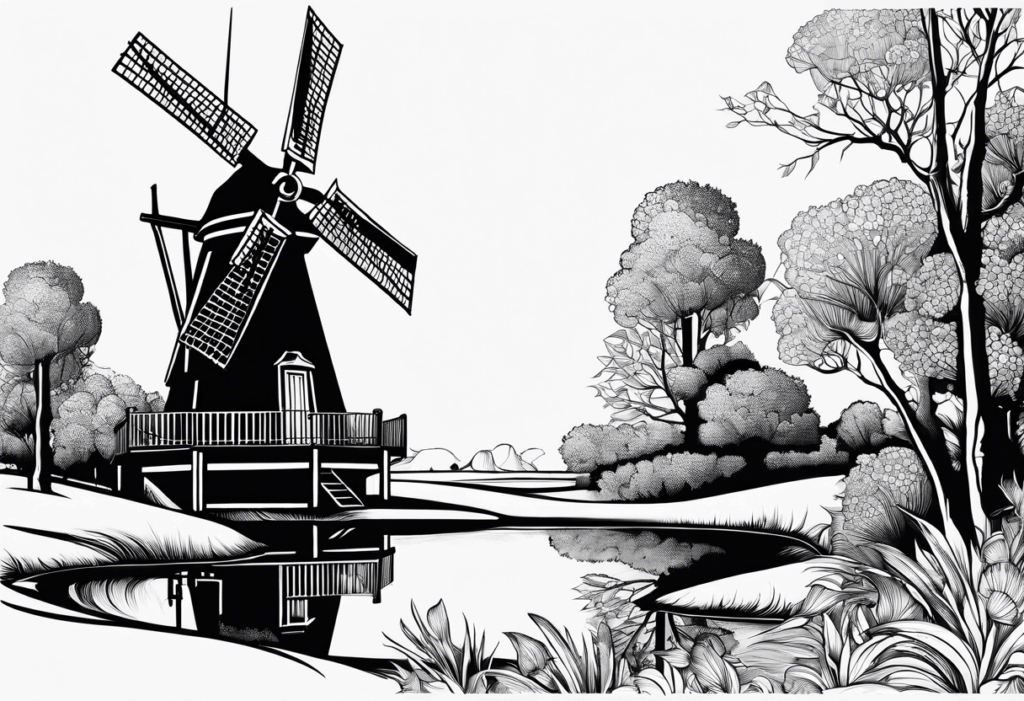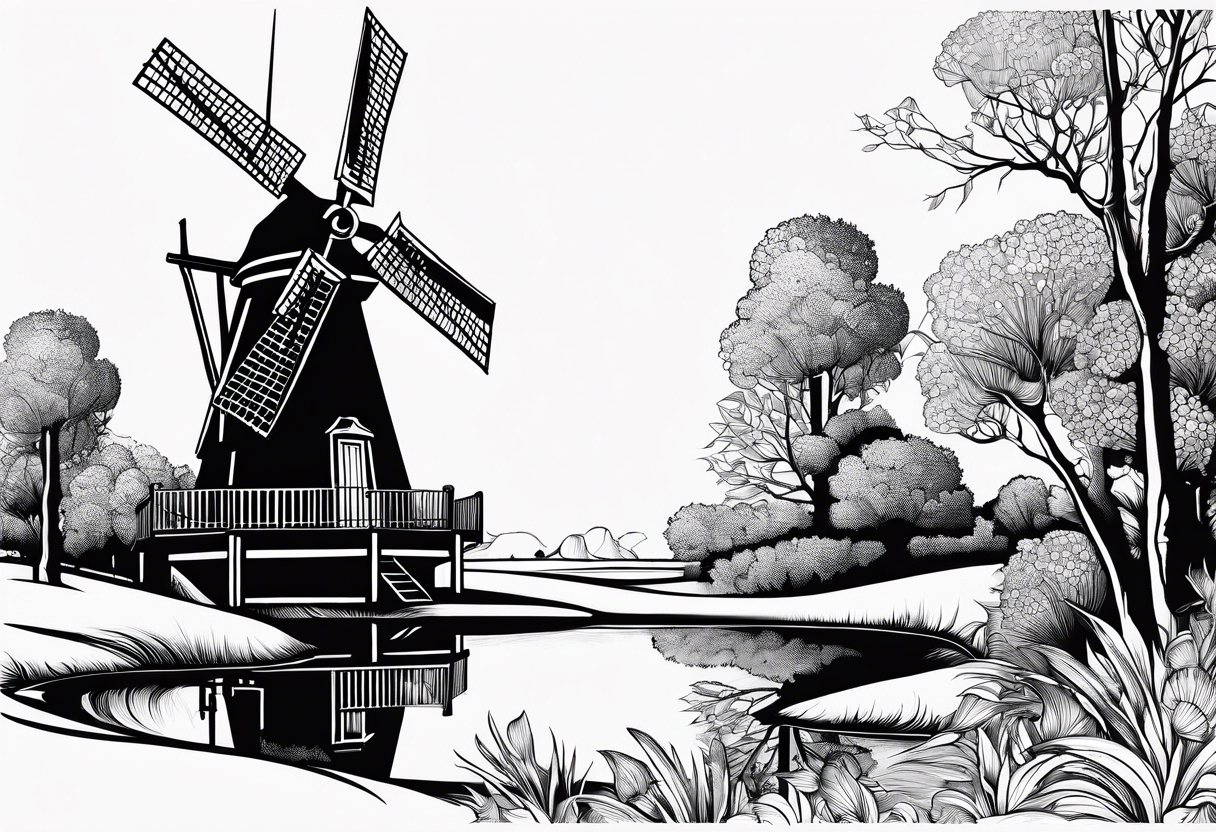
Dutch Windmill Tattoo Designs: A Timeless Symbol of Heritage and Resilience
The allure of Dutch windmill tattoo designs lies in their rich symbolism and striking visual appeal. More than just aesthetically pleasing body art, these tattoos represent a connection to heritage, resilience, and the enduring spirit of innovation. This article explores the history, symbolism, and diverse artistic interpretations of Dutch windmill tattoo designs, offering inspiration and insights for those considering this meaningful emblem.
The Historical Significance of Dutch Windmills
Windmills have been an integral part of the Dutch landscape for centuries. Originally used for grinding grain, they evolved to serve various purposes, including draining water, sawing wood, and even producing electricity. These iconic structures are not merely functional; they represent the Dutch ingenuity in harnessing natural resources and their persistent struggle against the sea. The Dutch windmill, therefore, embodies perseverance, resourcefulness, and a deep-rooted connection to the land.
Early Windmills: A Necessity for Survival
The earliest windmills in the Netherlands date back to the 13th century. Their primary function was to drain low-lying areas and reclaim land for agriculture and habitation. Without these windmills, much of the Netherlands would be submerged, highlighting their critical role in the nation’s survival and prosperity. Consequently, incorporating a Dutch windmill into a tattoo design reflects an appreciation for history and the power of human innovation.
Evolution of Windmill Technology
Over the centuries, Dutch windmills underwent significant technological advancements. Different types of windmills emerged, each suited for specific tasks. From the post mill to the smock mill and the polder mill, each design showcased the Dutch commitment to efficiency and adaptation. A Dutch windmill tattoo can thus represent not only history but also a celebration of continuous improvement and technological progress.
Symbolism Embedded in Dutch Windmill Tattoos
Beyond their historical context, Dutch windmill tattoo designs are laden with symbolism, making them a powerful form of self-expression. The symbolism can vary depending on the individual’s interpretation, but certain themes consistently emerge.
Resilience and Perseverance
The most prominent symbol associated with Dutch windmills is resilience. The ability of these structures to withstand harsh weather conditions and consistently perform their duties embodies the strength of the human spirit. A Dutch windmill tattoo can serve as a reminder of one’s own ability to overcome challenges and persevere through adversity. This makes them particularly appealing to individuals who have faced significant life obstacles.
Hope and Renewal
Windmills, by their very nature, harness the power of the wind to create something useful. This inherent connection to nature symbolizes hope and renewal. A Dutch windmill tattoo can represent a fresh start, a positive outlook, or a commitment to personal growth. The cyclical motion of the sails can also be interpreted as a symbol of continuous improvement and transformation.
Connection to Heritage
For individuals of Dutch descent, a Dutch windmill tattoo can be a powerful way to express their cultural heritage. It serves as a visual reminder of their ancestors’ resilience, ingenuity, and connection to the land. These tattoos are often chosen to honor family history and maintain a link to their cultural roots. [See also: Celtic Knot Tattoo Meanings]
Popular Dutch Windmill Tattoo Designs
The versatility of Dutch windmill tattoo designs allows for a wide range of artistic interpretations. From realistic depictions to stylized renderings, there’s a design to suit every taste and preference. Here are some of the most popular variations:
Realistic Windmill Tattoos
These tattoos aim to capture the intricate details and architectural accuracy of Dutch windmills. They often incorporate shading and perspective to create a three-dimensional effect. Realistic windmill tattoos are ideal for those who appreciate the beauty of the actual structures and want to showcase their artistic appreciation.
Silhouette Windmill Tattoos
Silhouette tattoos offer a minimalist yet impactful design. The Dutch windmill is depicted as a solid black outline against a contrasting background, such as the sky or a field. These tattoos are simple yet elegant, making them a popular choice for those who prefer understated designs.
Watercolor Windmill Tattoos
Watercolor tattoos utilize vibrant colors and fluid strokes to create a dreamy, ethereal effect. A Dutch windmill depicted in a watercolor style can evoke a sense of tranquility and beauty. The blending of colors can also symbolize the diverse landscapes of the Netherlands.
Geometric Windmill Tattoos
Geometric tattoos incorporate geometric shapes and patterns to create a modern and abstract design. A Dutch windmill rendered in a geometric style can represent structure, balance, and precision. These tattoos are ideal for those who appreciate clean lines and contemporary aesthetics.
Windmill with Landscape Tattoos
These designs combine the Dutch windmill with elements of the surrounding landscape, such as fields of tulips, canals, and traditional Dutch houses. These tattoos create a more comprehensive depiction of the Dutch countryside and can evoke a strong sense of place and belonging.
Placement Considerations for Dutch Windmill Tattoos
The placement of a Dutch windmill tattoo can significantly impact its visual impact and symbolism. Consider the size, design, and personal preferences when choosing the ideal location for your tattoo.
Arm Tattoos
The arm is a popular location for Dutch windmill tattoos, offering ample space for both large and small designs. Upper arm tattoos can be easily concealed, while forearm tattoos are more visible and can serve as a conversation starter. [See also: Compass Tattoo Placement Ideas]
Back Tattoos
The back provides a large canvas for intricate and detailed Dutch windmill tattoos. This location is ideal for designs that incorporate extensive landscapes or multiple windmills. Back tattoos can also be easily hidden or revealed, depending on the individual’s preference.
Leg Tattoos
Leg tattoos are another versatile option for Dutch windmill designs. Thigh tattoos offer ample space for larger designs, while calf tattoos are well-suited for smaller, more discreet tattoos. Leg tattoos can also be easily concealed or displayed, depending on the occasion.
Chest Tattoos
Chest tattoos are a bold and personal choice for Dutch windmill tattoos. This location is often chosen for designs that hold deep personal meaning. Chest tattoos can be partially visible, adding a touch of intrigue and mystery.
Choosing the Right Tattoo Artist
Selecting a skilled and experienced tattoo artist is crucial for achieving a high-quality Dutch windmill tattoo. Look for an artist who specializes in the style you desire, whether it’s realism, watercolor, or geometric. Review their portfolio carefully and read online reviews to ensure they have a proven track record of delivering exceptional results.
Researching Artist Portfolios
Before committing to a tattoo artist, thoroughly research their portfolio. Pay attention to the quality of their linework, shading, and color blending. Look for examples of Dutch windmill tattoos or similar designs to assess their ability to execute your vision. A reputable artist will be happy to provide references and answer any questions you may have.
Consulting with the Artist
Schedule a consultation with the tattoo artist to discuss your design ideas and placement preferences. This is an opportunity to get their expert advice and ensure that your vision is feasible. A good artist will be able to offer suggestions for improving the design and ensuring its longevity. They can also advise you on aftercare procedures to promote proper healing.
Aftercare for Your Dutch Windmill Tattoo
Proper aftercare is essential for ensuring that your Dutch windmill tattoo heals properly and maintains its vibrancy. Follow your tattoo artist’s instructions carefully and be diligent in your aftercare routine.
Cleaning and Moisturizing
Keep your new tattoo clean by gently washing it with mild soap and water several times a day. Pat it dry with a clean towel and apply a thin layer of fragrance-free moisturizer. Avoid using harsh chemicals or scrubbing the tattoo, as this can damage the skin and affect the ink.
Protecting from the Sun
Sun exposure can cause your tattoo to fade over time. Protect your Dutch windmill tattoo from the sun by applying a high-SPF sunscreen whenever you’re outdoors. Avoid tanning beds, as they can also damage the tattoo. With proper care, your tattoo will remain vibrant and beautiful for years to come.
In conclusion, Dutch windmill tattoo designs offer a unique blend of historical significance, symbolic meaning, and artistic versatility. Whether you’re drawn to their representation of resilience, their connection to heritage, or their aesthetic appeal, these tattoos are a powerful way to express your individuality and appreciation for this iconic symbol. By carefully considering the design, placement, and aftercare, you can ensure that your Dutch windmill tattoo becomes a cherished and enduring piece of body art. The beauty and symbolism of a Dutch windmill can now be a part of you forever.

